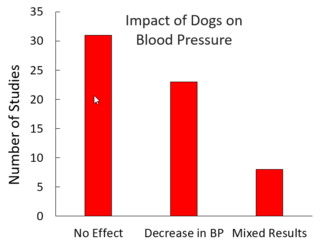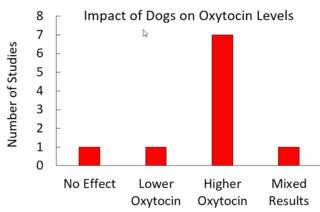Health
Is Time With Pets Good for Our Cardiovascular Health?
The surprising results of 129 studies on dogs' affect on human health.
Posted August 11, 2022 Reviewed by Vanessa Lancaster
Key points
- Media reports often claim that interacting with pets lowers blood pressure and decreases stress levels.
- Researchers have investigated the impact of pets on the human cardiovascular system for four decades.
- An analysis of 129 studies on the physiological impacts of interacting with dogs uncovered a surprising pattern of results.

The New York Times recently published an op-ed by Times opinion writer Margaret Renkl titled "Your Pandemic Puppy Was Not a Mistake." Renkl described how much she has benefited from canine companionship during COVID. She wrote:
The well-studied health benefits (of pet ownership)… are extravagant. A beloved dog will lower a person’s blood pressure, reduce stress hormones, calm anxiety, and even make it easier to interact with other human beings.
Margret Renkl was correct in stating the impact of pets on the human cardiovascular system and stress levels has been extensively studied.
Indeed, a 1983 paper in the Journal of Nervous and Mental Disorders helped jumpstart the field of anthrozoology—the study of human-animal relationships. In it, Dr. Erika Friedmann and her colleagues found that just the presence of a friendly dog reduced the blood pressure and heart rates of children in a stressful situation—reading poetry aloud.
The Results of 129 Studies on the Biology of the Human-Dog Bond
However, the results of any single study—no matter how high the quality of the research–can be a fluke. (See "Why Most Published Research Findings Are False.") That’s why researchers look for consistent patterns of results based on multiple studies. Fortunately, web search engines such as Pub Med and Google Scholar have made it easier for investigators to compile the results of nearly all the studies in specific research areas. These are called “systematic reviews.” Renkl’s article in the Times inspired me to search for a systematic review of the growing body of research on the impact of interacting with pets on human physiological responses.
Thanks to the magic of Google Scholar, it took me only a few minutes to find what I was looking for. An Australian research team led by Jillian Teo recently conducted a systematic review of research on the biology underlying the human-animal bond. Their results appeared in the International Journal of Psychophysiology.
The research team located 129 published studies. Of these, 62 reported effects on blood pressure, 65 examined heart rate, and 48 looked at the stress hormone cortisol. I have generally been skeptical of the pet industry's claims that pet owners are healthier than non-pet owners. (See "Are Pets as Good for Us as We Think They Are?") But I thought the evidence that interacting with dogs had beneficial short-term effects on our cardiovascular system was rock solid. It seems I was wrong.
Does Interacting With Dogs Lower Blood Pressure?
The media and pet industry tout the idea that interacting with pets causes a reduction in their owners' blood pressure. Does the preponderance of published studies support this claim? Not quite. Only 23 of the 62 blood pressure studies reported decreases in systolic, diastolic, and arterial blood pressure.

Thirty-one of the studies found no effect on the three measures, and eight reported mixed results—for example, no change in diastolic blood pressure but an increase in systolic blood pressure.
Teo and her team concluded that approximately one-third of the studies provided some evidence that human-dog interactions may have a favorable impact on an individual's autonomic nervous system.
Does Interacting With Dogs Lower Heart Rates?
The Australian researchers located 65 studies that examined heart rate. In 22 of them, interacting with dogs was associated with decreased heart rates. But in 37 of them, interacting with a dog did not significantly affect heart rate. (In six studies, interacting with dogs was associated with increased heart rate, but the authors suggest this was due to physical activity.)
Does Interacting With Dogs Lower Respiration Rates?
Only seven studies have looked at changes in respiration rates associated with interacting with dogs. Of these, three found no effect of interacting with dogs on respiration rate, while three reported that interacting with dogs produced lower respiration rates. (The other study had too few subjects to make a meaningful comparison.)
Does Interacting With Dogs Lower Stress Levels?
The adrenal glands produce cortisol, which is associated with elevated stress levels. Jillian Teo’s research team located 48 studies that examined cortisol levels in the presence of a dog. They found that different methods of measuring cortisol produced different patterns of results. For example, seven studies assessed cortisol using blood samples (“serum cortisol”). Six of these found interacting with dogs resulted in lower cortisol levels.
However, the results of the 40 studies which measured salivary cortisol levels were not as rosy–only 18 reported positive results. Another 18 studies using salivary cortisol found no effect of interacting with dogs. And levels of the stress hormone went up in four of the salivary studies. (However, these increases may have resulted from dog agility competitions.)
Does Interacting With a Dog Increase Oxytocin Levels?
The hormone oxytocin has been extolled as the biochemical glue that cements the human-animal bond. Is there any truth to such claims? The Australian team found 10 human-dog relationship studies that measured changes in oxytocin. Six of these measured oxytocin levels in the blood (serum oxytocin). Of these, five found, as expected, that the hormone increased when people interacted with dogs. Similarly, two studies examined oxytocin in saliva, and both of them found positive results.

The results of two studies that looked at oxy in urine samples were mixed. One found that oxytocin increased only among owners who gazed at their dogs, and the other found interacting with dogs did not affect oxytocin production.
Separating Media Hype From Research Results
The fact is that most published peer-reviewed studies have not found that interacting with dogs lowers blood pressure or heart rates or reduces levels of stress hormones. Further, it is likely that other studies also found little or no effects of dogs on hormone levels or blood pressure, but they were never published (the "file drawer effect").
In short, the evidence that interacting with dogs has beneficial short-term effects on our physiology is not as strong as I thought. Indeed, the only really convincing evidence Teos’s team found was that the presence of a dog was associated with an increase in oxytocin. Claims like Margaret Renkl’s statement in the Times that “A beloved dog will lower a person’s blood pressure, reduce stress hormones, calm anxiety” are misleading. Instead, they are based on cherry-picking the "good news" results and ignoring the studies that found negative results.
Keep in mind, however, that roughly a third of studies did find significant beneficial effects of interacting with dogs on blood pressure, heart rate, and stress levels. As Dr. Kerri Rodriguez reminded me, inconsistency is common in the results of studies of human-animal interactions. Indeed, along with Nancy Gee, we recently published a paper on why this is the case. (See Variability in Human-Animal Interaction Research.)
As Bob Dylan said, “Something is happening here, but we don’t know what it is….”
Facebook image: Halfpoint/Shutterstock
LinkedIn image: Dean Drobot/Shutterstock
References
Friedmann, E., Katcher, A. H., Thomas, S. A., Lynch, J. J., & Messent, P. R. (1983). Social interaction and blood pressure: influence of animal companions. Journal of Nervous and Mental Disease. 171, 8, 461-465.
Teo, J. T., Johnstone, S. J., Römer, S. S., & Thomas, S. J. (2022). Psychophysiological mechanisms underlying the potential health benefits of human-dog interactions: A systematic literature review. International Journal of Psychophysiology.
Herzog, H. (2011). The impact of pets on human health and psychological well-being: fact, fiction, or hypothesis?. Current directions in psychological science, 20(4), 236-239.
Rodriguez, K. E., Herzog, H., & Gee, N. R. (2021). Variability in human-animal interaction research. Frontiers in Veterinary Science, 7, 619600.




